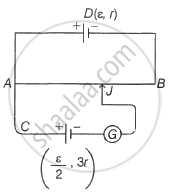Advertisements
Advertisements
Question
A potentiometer wire AB having length L and resistance 12r is joined to a cell D of emf ε and internal resistance r. A cell C having emt `ε/2` and internal resistance 3r is connected. The length AJ at which the galvanometer as shown in the figure shows no deflection is ______.

Options
`5/12` L
`11/12` L
`13/24` L
`11/24` L
Solution
A potentiometer wire AB having length L and resistance 12r is joined to a cell D of emf ε and internal resistance r. A cell C having emt `ε/2` and internal resistance 3r is connected. The length AJ at which the galvanometer as shown in the figure shows no deflection is `underlinebb(13/24 "L")`.
Explanation:
Given, the length of the wire, AB = L
Resistance of wire, AB = 12r
emf of cell D = ε, internal resistance of D = r
emf of cell C = `ε/2`, internal resistance of C = 3r
Current in potentiometer wire (i) = `"Total emf"/"Total resistance"`
`i = ε/(r + 12r) = ε/(13r)`
The potential drop across the balance length AJ of the potentiometer wire is VAJ = i × RAJ
⇒ VAJ = i(resistance per unit length × length AJ)
VAJ = `i((12r)/L xx x)`
where x is the balance length AJ.
As a null point occurs at J, so potential drop across balance length,
AJ = emf of cell C
VAJ = `ε/2 ⇒ i((12r)/L xx x) = ε/2`
⇒ `ε/(13r) xx (12r)/L xx x = ε/2 ⇒ x = 13/24` L
